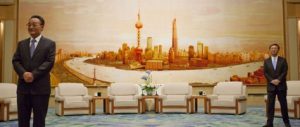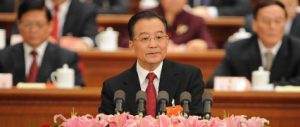Five-year plans (FYPs), which set down and clarify national strategy, are one of China’s most important policy tools. Just as they have helped to drive China’s economic success over recent decades, so they will play a pivotal role in putting the country on a green development path. The 12th Five-Year Plan, now under consideration by the National People’s Congress, marks the beginning of that process in earnest.
FYPs embody the concept of progressing by degrees, or developing step by step. This approach has been one of the driving forces behind China’s economic progress in recent decades, and will now provide the platform for its green development. It is the methodology underpinning China’s socialist modernisation: to reach a new step in development every five years. Unstinting efforts over a number of FYPs have driven China’s transformation.
Climate change presents a long-term and all-encompassing challenge for China. It demands a long-term development strategy and broad goals, as well as near-term action plans and concrete policies. Combining these is precisely the idea behind FYPs.
At the global climate-change summit in Copenhagen in 2009, China demonstrated it has the long-term political will to respond to climate change; to work with the world to limit global temperatures to no more than two degrees Celsius above pre-industrial temperatures (the goal set out in the Copenhagen Accord). In November that year, the Chinese government formally put forward its medium-term targets on climate change: a reduction in energy intensity of 40% to 45% on 2005 levels by 2020, and generation of 15% of energy from non-fossil fuel sources by the same date.
The period from 2005 to 2020 takes in three FYPs, the 11th, 12th and 13th. In each five-year period, national circumstances and long-term strategy will inform the selection of appropriate targets. In this way, further steps towards the medium-term development goals set for 2020 – themselves part of a longer-term green development strategy – will be taken. The development philosophy of China’s five-year plans will be combined with its green development strategy.
We have already seen some success in the 11th FYP period (2005 to 2010), during which China met its energy-saving and emission-reduction targets, a good first step towards achieving 2020 targets. Next we need to research, set and implement energy-saving and emission-reduction goals for the 12th FYP, taking further steps along the same path.
One of the key strengths of Chinese socialism is its capacity for long-term, national-level planning – its political continuity. FYPs are an important example of this. Despite the twists and turns of history, China has held firm in its modernisation goals. China is one of the few nations able to pursue long-term development goals, rather than chop and change as political parties with differing stances succeed one another.
Long-term policy continuity is vital for dealing with issues like climate change. Cutting greenhouse-gas emissions and building a low-carbon economy require an overhaul of both our mode of economic development and our lifestyles. Achieving this requires perseverance. This is where China’s policymaking framework shows its strengths. China’s enduring and stable political system, in combination with its five-year planning structure, will ensure that the country maintains a consistent, long-term strategy for tackling climate change at the same time as formulating policies that respond to the needs of the time.
These are strengths many other nations lack. The classic example is the United States. During the presidency of George W Bush – a Republican – the US neglected its emissions-reduction responsibilities and refused to ratify the Kyoto Protocol. When Democrat president Barack Obama took power, there was a policy turnaround and the United States became actively involved in global climate-change cooperation and investment in renewable energy. But then came last year’s mid-term elections, and the Republican party seized back control of the House of Representatives, the lower chamber of the US senate; a major setback for the Democrats that has left a question mark hanging over a number of Obama’s green reforms.
China’s political advantages are clear. It needs to make further use of these, using five-year plans as the basis for steady progress towards green development.
Successes in energy-saving and emissions-reduction over the last five years give us a taste of what’s to come. In our evaluation of the 11th FYP, we found that targets on population, resource conservation and environment were all fulfilled. Energy intensity dropped by about 20% as planned. Arable land cover was held at 1.2 million square kilometres, a higher figure than was targeted.
Meanwhile, water consumption per unit of industrial value added dropped 35% against a target of 30%. The coefficient of effective use of water for irrigation reached the targeted 0.5. And chemical oxygen demand (an indirect measure of water pollution) dropped by 14%.
Carbon-dioxide emissions also fell – by an accumulative 12% – more than the 10% goal mandated by the plan. The binding targets for energy-saving and emission-reduction in particular showed the value of “hard limits”. Major progress was made on green development, providing important experience for further implementation during the 12th FYP.
The 12th FYP is the first for which the theme will be green development. Again, a point will be made of the need to “construct a resource-conserving and environmentally friendly society”. The plan will explicitly say that, faced with ever-stronger environmental and resource constraints, China must increase its sense of urgency and establish concepts of green and low-carbon development. With a focus on energy-saving and emission-reduction, it must introduce incentives and disincentives to help promote resource conservation and green production and consumption.
The green development strategy has six supporting pillars, each with its own section in the plan: actively responding to climate change; strengthening conservation and management of resources; developing the “circular economy”; enhancing environmental protection; promoting ecological protection and restoration; and strengthening systems for water management and disaster prevention and alleviation.
Green development targets are also more apparent in the new FYP. Population goals aside, the number of resource and environmental targets accounts for 33.3% of the total, up from 27.2% in the 11th FYP. It also sets the key aims that will frame China’s response to climate change. These include: reductions in carbon-dioxide intensity, reductions in carbon-dioxide emissions – by increasing the proportion of non-fossil fuels in energy structure – and the creation of new forest areas to boost forest cover, timber reserves and carbon sinks.
The 12th FYP sets out both “carrot” and “stick” approaches. For the first time, this FYP aims to reform resource pricing and establish a system of payment for environmental services. It requires stronger assessment of responsibility for energy-saving and emission-reduction targets, appropriate control of total energy consumption and the application of green development in all economic activity.
Also for the first time, the 12th FYP puts forward an “ecological security” strategy. In areas where development is limited or banned, ecological protection will be rigorously enforced and green buffer zones will be used to shield vulnerable land. There will also be funding for specific ecological restoration projects, so that our children and grandchildren will be able to enjoy a beautiful China.
The 12th FYP is a true green development plan, which marks China’s entry into a green development era. It is a historical moment: the point at which China launches – and joins – the global green revolution and adopts a concrete plan of action for responding to climate change. The positive effects will be felt worldwide.
Hu Angang is one of China’s best-known economists. He is professor at the Chinese Academy of Sciences and Tsinghua University and the director of the Centre for China Study, a leading policy think-tank. Hu has worked as the chief editor for China Studies Report, a circulated reference for senior officials.
Liang Jiaochen is a PhD student at Tsinghua University’s School of Public Policy and Management.
Homepage image from Greenpeace


